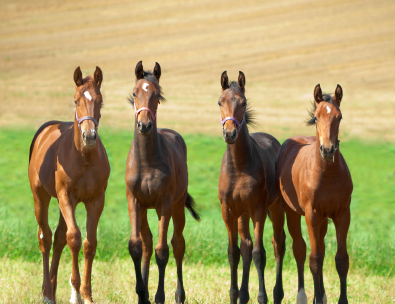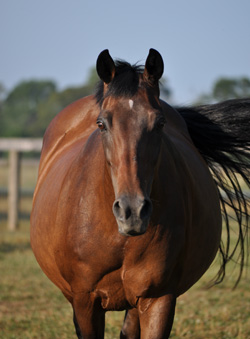 There are many milestones in the life of a foal. They start as big ones like standing, nursing, and meeting their dam for the first time. Yet as a foal ages and summer days begin to lengthen one major milestone looms over the foal…Weaning Day. From the perspective of a veterinarian, Dr. David Scofield walks us through the important aspects of weaning.
There are many milestones in the life of a foal. They start as big ones like standing, nursing, and meeting their dam for the first time. Yet as a foal ages and summer days begin to lengthen one major milestone looms over the foal…Weaning Day. From the perspective of a veterinarian, Dr. David Scofield walks us through the important aspects of weaning.
Many different methods, ideologies, and protocols exist for the actual weaning process. Farms may use historical dogma, current trends, or a hodgepodge of techniques to break the bond between dam and foal. We will explore aspects of weaning procedures and where management decisions can be made to benefit the health of the foal, and in some cases, the dam as well. I have chosen to focus on three major aspects of the process: Preparation, Stress, and Health Status.
Preparing for the Big Day
Preparation of the facility and staff is a critical first step when beginning the weaning process. The area where weaning will take place should be scouted for obstacles, debris, sharp objects, bucket hangers, or anything that a confused and scared weanling may encounter. These objects should be removed and fencing should be checked for broken boards, sharp nails, and sturdiness. If you choose to perform an incomplete or gradual weaning the fence must be made stout enough to separate a hungry foal from their dam and prevent the foal from being able to nurse through the fence line.
Other aspects of preparation involve housing and feeding considerations. Early on in life, foals will begin to eat small amounts of hay and grain from the dam’s daily feedings. Gradually, the amount of solid hay and grain a foal will consume will increase, so that by 3 months of age, only about 50% of the total energy and protein a foal consumes comes from the dam. Some operations choose to offer a highly palatable creep ration to foals. In any case, the foals should be accustomed to solid food sources and have some level of independence from the dam prior to weaning.
Minimize Stress for Mare and Foal
One aspect that must be minimized is stress. Stress in adults and weanlings will decrease the immunologic response to vaccines, decrease nutrient and caloric intake, and increase the difficulty of weaning. Stress reduction must be included in the weaning process for both the mare and foal to mitigate the negative effects of stress.
A great way to minimize stress is to batch raise groups of foals of like age. Having a group of foals that are comfortable with each other can certainly lessen the blow, so to say, when the dams are removed. Keeping the weanlings in a familiar location or paddock is beneficial and potentially adding an older gelding, non-lactating mare, or other “herd mate” such as a goat will help foals become accustomed to life post weaning. Adding an older horse can provide herd structure and a model of behavior for the new weanlings.
The methods of actual weaning change the amount of stress a foal undergoes at weaning. Methods utilizing a gradual or incomplete separation have been shown to decrease stress on the foal, prevent weight loss, and dehydration when compared to traditional abrupt weaning systems. If your facility is capable of using one of these intensive programs, it may be worth the extra effort for your foal crop.
Vaccinating and Deworming The Weanling
Colostrum is arguably the most critical component for the health of the neonate. We know that high quality and adequate volume of colostrum is one of the best management tactics to provide a foal immunologic protection for the first few months of life. Maternally derived antibodies against disease are absorbed by the foal and utilized to give immunologic protection for the naïve neonate. We don't have adequate knowledge on exactly when maternal antibodies cease protecting the foal, and variables such as colostrum quality, volume, absorption, and maternal immune status at the time of making colostrum will all have great effects on the duration of protection colostrum affords to the foal. Furthermore, maternally derived antibodies limit or block the efficacy of foal vaccination by preventing exposure of the vaccine to the immune system of the foal. This phenomenon, known as maternal antibody interference, can limit the efficacy of vaccines up until six months of age. Studies have determined the half-life, or the time it takes the number of protective immunologic molecules to decrease by one half, is 25 to 40 days. So by 80 days of life, a foal that had nursed adequate high quality colostrum within 24 hours of birth has already seen a decrease of two half-lives (or 75%) of the maternally derived IgG acquired in the colostrum. If the foal had utilized some of those IgG molecules to stave off an infection of bacterial or viral origin, the amount of circulating IgG may be significantly lower than expected.
For most, weaning coincides with a foal’s first series of vaccinations. These are timed specifically at months 4-6 when maternal antibodies have declined to a point where a foal can respond to an immune challenge from a vaccine antigen and begin to develop protective immunity. Most all vaccine schedules for foals include a second booster vaccine 3-4 weeks after the initial vaccine. This booster allows the immune system to develop high levels of protective and specific antibodies to the diseases vaccinated against. The American Association of Equine Practitioners has a great resource available to veterinarians and owners with recommended guidelines for vaccinating all types and ages of horses. The website categorizes vaccines into a set of “core” vaccines that all horses should receive, and then highlights “risk” based vaccines. Be sure to discuss with your veterinarian regarding what diseases should be included for a complete immunization protocol in your area.
As part of any good health program for foals, management of internal parasites is a critical component at the time of weaning. Following weaning, foals are exposed to increased internal parasites load since they are consuming more parasite-laden grasses and forage. All foals should to be on a regular rotational deworming schedule at 30 or 60-day intervals, including at the time of weaning. By decreasing parasite load, gastrointestinal aberrations and post weaning weight loss can be minimized.
The Mare Post-Weaning
 Following weaning, it is also important to think about the dam. Mastitis, although not terribly common in the mare, has a higher incidence following weaning than at other times of lactation. Mares need the pressure in the udder and mammary gland to be increased to shut down lactation. It can be uncomfortable for mares that have begun to dry off, but do not milk the mare out or stimulate her udder. Even touching or manipulation of the udder will release pulses of oxytocin from the posterior pituitary gland, causing milk let-down and further discomfort. Some practitioners administer a few days of a non-steroidal anti-inflammatory agent (NSAID) such as flunixin meglumine or phenylbutazone and remove excess grain or energy to help arrest lactation.
Following weaning, it is also important to think about the dam. Mastitis, although not terribly common in the mare, has a higher incidence following weaning than at other times of lactation. Mares need the pressure in the udder and mammary gland to be increased to shut down lactation. It can be uncomfortable for mares that have begun to dry off, but do not milk the mare out or stimulate her udder. Even touching or manipulation of the udder will release pulses of oxytocin from the posterior pituitary gland, causing milk let-down and further discomfort. Some practitioners administer a few days of a non-steroidal anti-inflammatory agent (NSAID) such as flunixin meglumine or phenylbutazone and remove excess grain or energy to help arrest lactation.
Caring for a foal, parturition, and lactation is a large metabolic drain on a mare’s body and nutrient stores. Mares need to replenish fat, nutrient, and trace mineral stores for a subsequent foal (if she is pregnant) or for future pregnancies. For more information about Feeding the Pregnant Mare you can read the article written by Dr. Clare Thunes. Mares should be fed to provide maximum energy to replace lost conditioning and to surpass daily NRC guidelines for trace minerals.
Having a plan in place with detailed dates, locations, and actions to be performed will help prepare each member of the team for the weaning of a foal crop. Proper planning and attention to foal health, mare health, and stress reduction will facilitate the weaning process and hopefully prevent any injury or sickness on the large milestone day of weaning.


Log in to join the conversation.